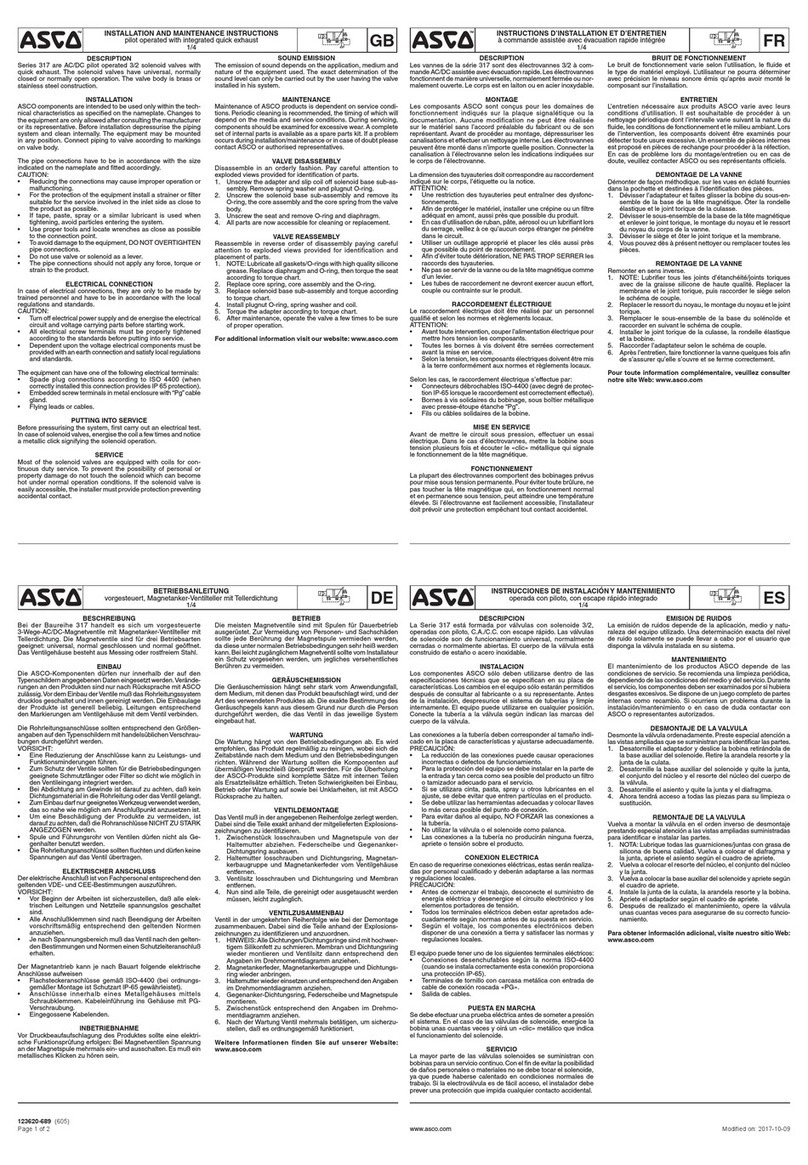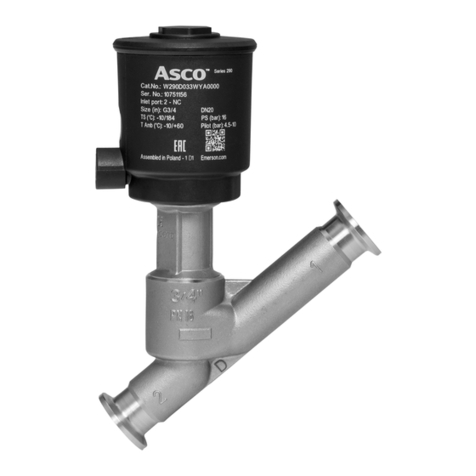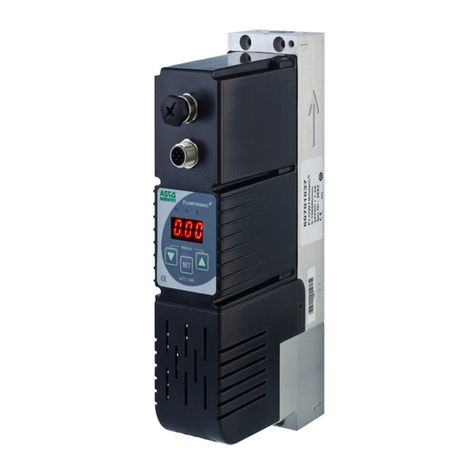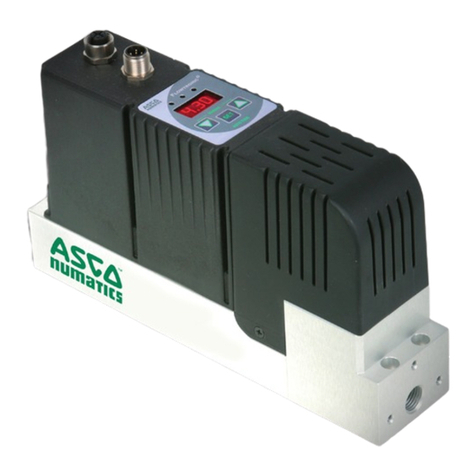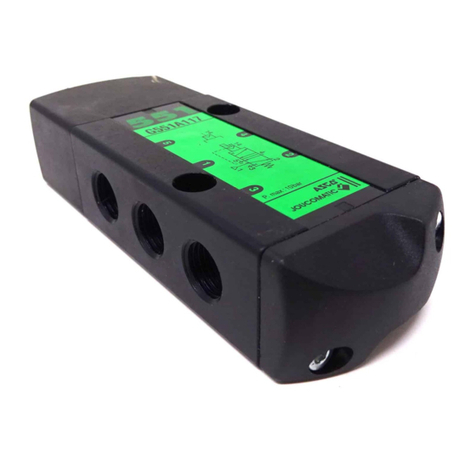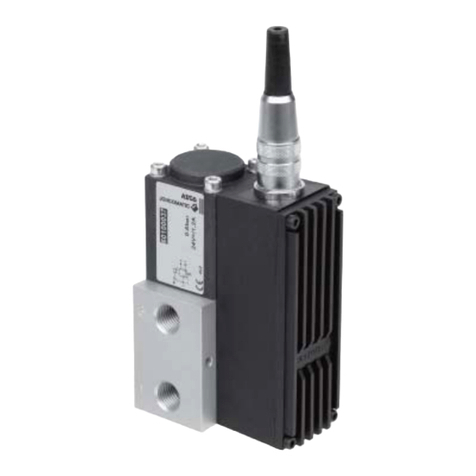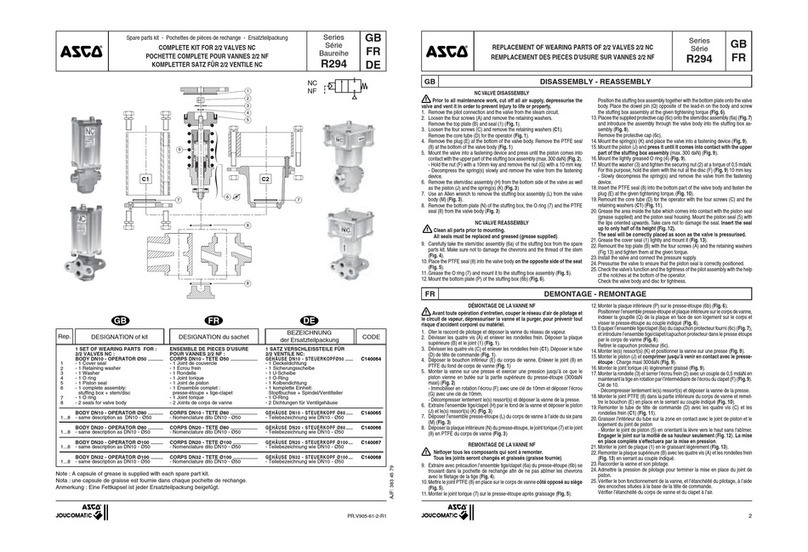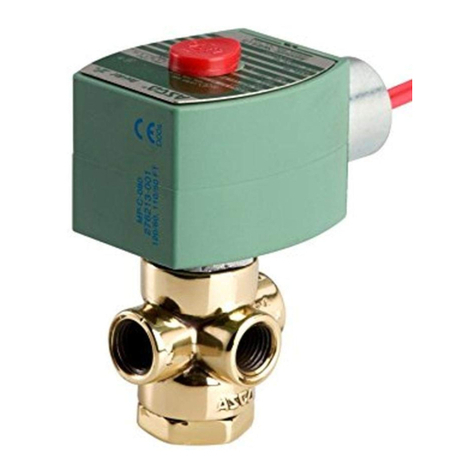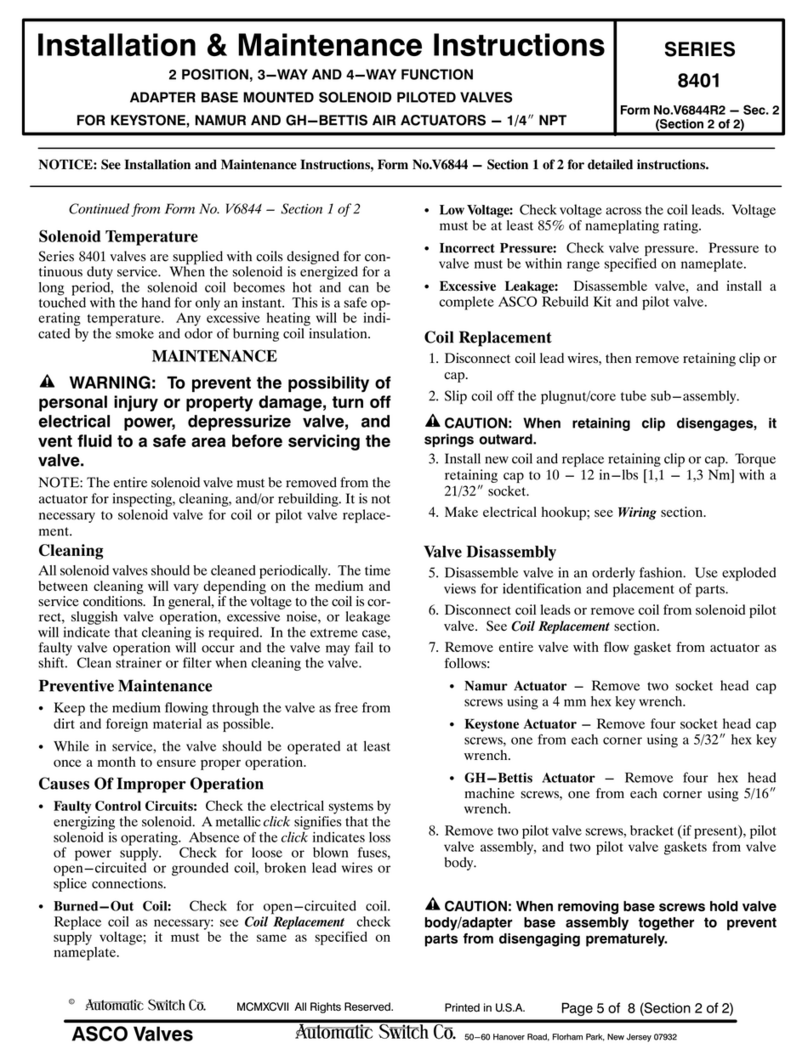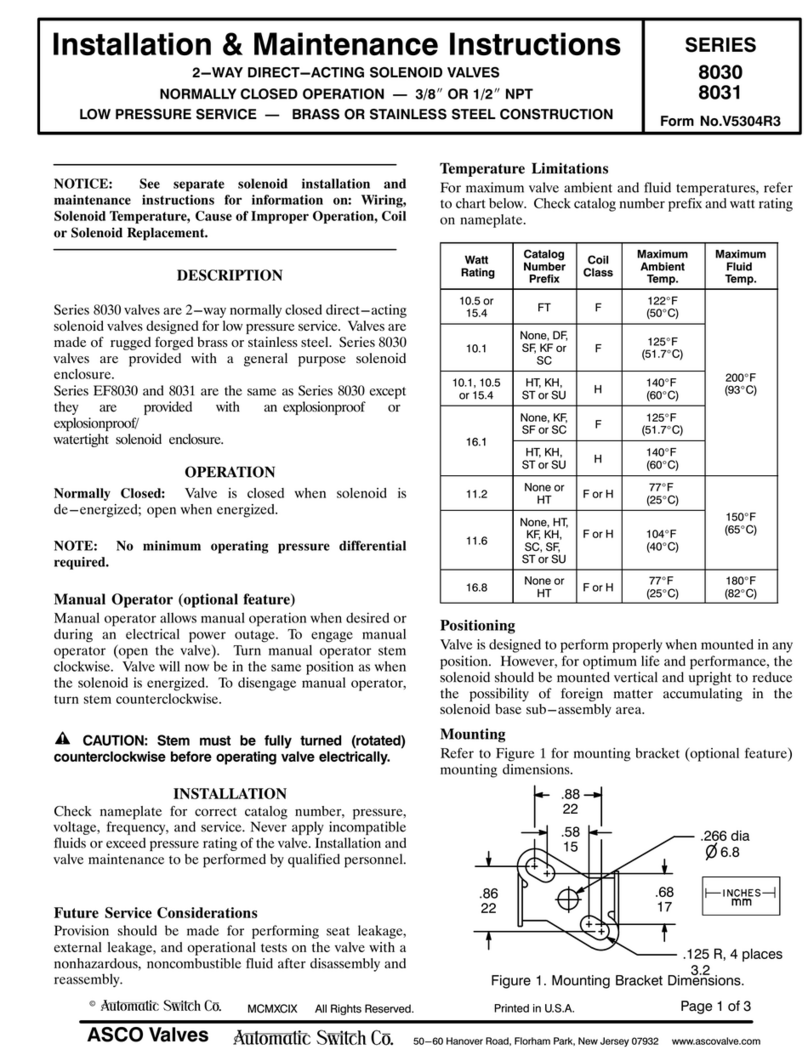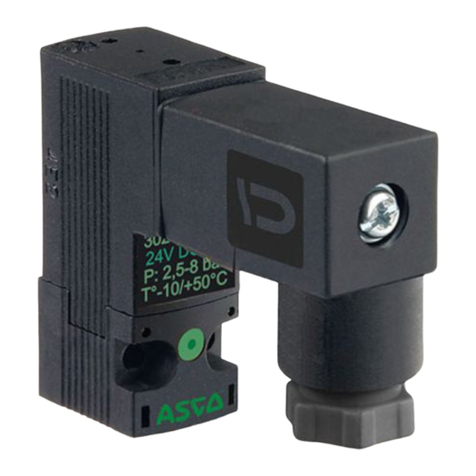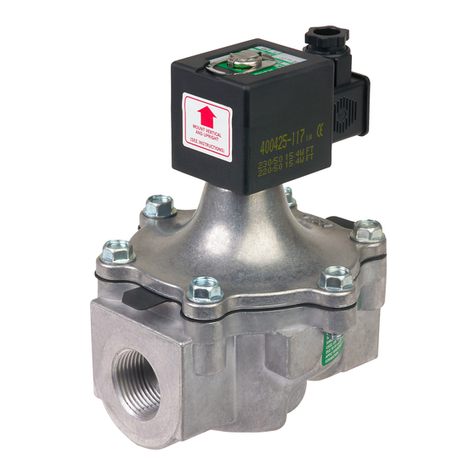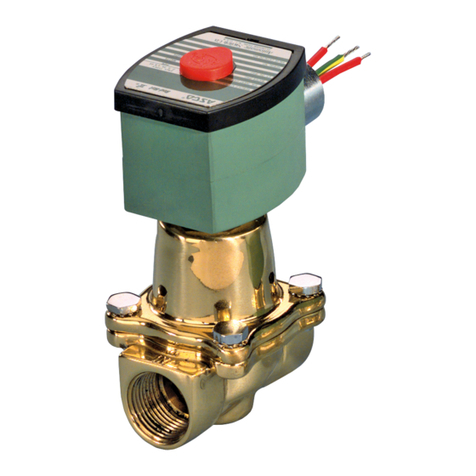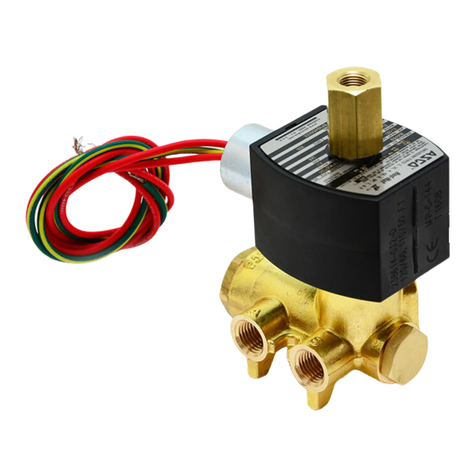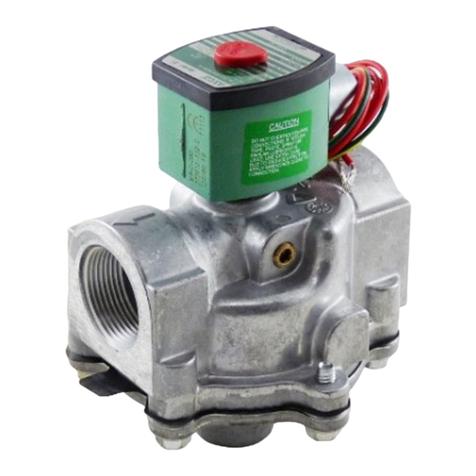
50-60 Hanover Road, Florham Park, New Jersey 07 32
ASCO Valves
Page 4 of 4 Form No.V6861R1
5. A 4-40 machine screw provided in ASCO Rebuild Kit
serves as a self-tapping screw to remove insert from body.
Thread screw a few turns into through hole located in flat
surface of the insert.
CAUTION: Do not damage center hole (pilot ori ice) in
raised sur ace o insert.
6. Remove insert by using a pair of pliers to grip the head of
the screw. Then pull insert with gaskets from body insert
cavity.
7. Remove three gaskets from insert. Tag each as they are
removed so that they can be reassembled in the same
location. Middle and lower gaskets are the same size,
however, the lower gaskets is a softer material. Then
remove disc holder sub-assembly, disc spring, and shim.
8. The solenoid pilot is now completely disassembled.
9. Remove long body screws (4) and lockwashers (4) from
piston end body. Slip piston end body off piston/shaft
sub-assembly.
10. Remove small body gaskets (2) from counterbores in
piston end body.
11. Slide piston/shaft sub-assembly form main valve body.
The piston/shaft sub-assembly is comprised of the main
shaft, shaft nut, shaft washer, piston, body u-cup, guide
u-cup, shaft gasket, piston guide, seat gasket, guide
gaskets (2) and a resilient main disc.
12. Disassemble piston/shaft assembly by inserting a brass rod
(of suitable size) into cross hole in shaft. Rod must be
brass or made of another soft material, so as not to burr
edges of hole. Hold piston shaft firmly (with rod) and
unscrew shaft nut.
13. Disassemble piston/shaft sub-assembly in an orderly
fashion. Be careful not to damage or mar any of the parts.
14. Remove shaft nut, shaft washer, piston with body and
guide-u-cups (2) attached from shaft. Then remove
body u-cup and guide u-cup from piston.
15. Remove shaft gasket, piston guide, guide gaskets (2) seat
gasket, and resilient main disc.
16. Remove short body screws (4) and lockwashers (4) from
opposite end of main valve body. Remove body/seat
gasket and seat gasket from seat. Then remove the other
resilient main disc from bore of main valve body.
17. All parts are now accessible to clean or replace. If parts
are worn or damaged install a complete ASCO Rebuild
Kit.
Valve Reassembly or 3/4I, or 1I NPT Valves
IMPORTANT: Install all parts supplied in ASCO Rebuild Kit.
Do not mix old and new parts.
1. Lubricate cartridge gaskets, orifice gasket, body/seat
gasket, seat gasket, upper, middle and lower insert gaskets
with DOW CORNINGr 200 fluid lubricant or an
e uivalent high-grade silicone fluid lubricant.
2. Lubricate all remaining gaskets, u-cups, bores of piston,
piston end body, and the main disc sliding area on the
main shaft with a light coat with DOW CORNINGr 111
Compound lubricant. For valves with Suffix MF in the
catalog number, lubricate main disc slide area with
William F. Nye, Inc. Fluorocarbon Gel 852B.
3. Preassemble piston/shaft sub-assembly as follows:
A. Position resilient main disc on shaft so that resilient
lip side of disc is facing the piston guide.
B. Install seat gasket and guide gaskets (2) on piston
guide.
C. Slip piston guide with gaskets onto shaft.
D. Position shaft gasket on shaft.
E. Install guide u-cup and body u-cup on piston.
Make certain that open end of guide u-cup faces, the
main valve body, while open end of body u-cup faces
the piston end body. Position the piston with u-cups
on shaft.
F. Replace shaft washer and shaft nut. Tor ue the shaft
nut to 125 ± 10 in-lbs [14,1 ± 1,1 Nm] while holding
the shaft as described in Valve Disassembly for 3/4I or
1I NPT valves section step 12.
4. Install piston/shaft sub-assembly in main valve body.
5. Position small body gaskets (2) in counterbores in piston
end body.
6. Slip piston end body over the piston/shaft sub-assembly.
Then install four long body screws with lockwashers.
Tor ue the long body screws (4) in a crisscross manner to
40 ± 5 in-lbs [4,5 ± 0,6 Nm].
7. Install resilient main disc at opposite end of main shaft.
Be sure resilient side of disc is facing seat.
8. Position seat gasket and body/seat gasket on seat.
9. Install seat with gaskets into main valve body. Replace
lockwashers (4) and short body screws (4). Tor ue body
screws in a crisscross manner to 40 ± 5 in-lbs [4,5 ± 0,6
Nm].
10. Position shim, lower insert gasket, and disc holder spring
in body insert cavity.
11. Snap upper and middle insert gaskets into grooves of
insert. Lower insert gasket fits into the recess between the
lower corner of the insert and the lower corner of the body
insert cavity. Middle and lower insert gaskets are the same
size. However, the lower gasket is made of a softer
material.
12. Place disc holder sub-assembly into insert. Install
insert(with gaskets and disc holder assembly) into body
insert cavity, making certain that the disc holder spring is
centered. Rotate this assembly slightly while pushing
downward to aid installation.
13. Position cartridge gasket on insert in valve body.
14. Install orifice gasket in recess in base of cartridge
assembly.
15. Thread cartridge assembly with orifice gasket into valve
body. Then tor ue cartridge assembly to 175 ± 25 in-lbs
[19,8 ± 2,8 Nm].
16. Install solenoid, see separate instructions. Then make up
piping to pilot exhaust on top of solenoid and electrical
connection to solenoid.
WARNING: To prevent the possibility o personal
injury or property damage, check valve or proper
operation be ore returning to service. Also per orm
internal seat and external leakage tests with a
nonhazardous, noncombustible luid.
17. Restore line pressure and electrical power supply to valve.
ORDERING INFORMATION
FOR ASCO REBUILD KITS
Parts marked with an asterisk (*) in the exploded view are supplied in
Rebuild Kits. When Ordering Rebuild Kits for ASCO valves, order
the Rebuild Kit number stamped on the valve nameplate. If the
number of the kit is not visible, order by indicating the number of kits
re uired, and the Catalog Number and Serial Number of the valve(s)
for which they are intended.
